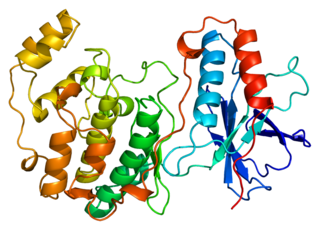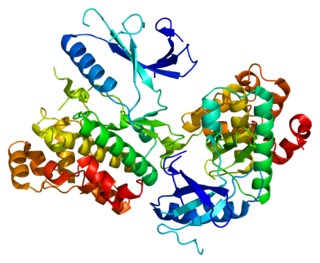MAP kinase-activated protein kinase 2 is an enzyme that in humans is encoded by the MAPKAPK2 gene. [5] [6] [7]
MAP kinase-activated protein kinase 2 is an enzyme that in humans is encoded by the MAPKAPK2 gene. [5] [6] [7]
This gene encodes a member of the Ser/Thr protein kinase family. This kinase is regulated through direct phosphorylation by p38 MAP kinase. In conjunction with p38 MAP kinase, this kinase is known to be involved in many cellular processes including stress and inflammatory responses, nuclear export, gene expression regulation and cell proliferation. Heat shock protein HSP27 was shown to be its major direct substrate in vivo. Two transcript variants encoding two different isoforms have been found for this gene. [8]
MK2 pathway has been demonstrated to have a key role in maintaining and repairing the integrity of endothelial barrier in the lung via actin [9] and vimentin remodeling. Activation of MK2 via its phosphorylation by p38 has been shown to restore the vascular barrier [7] and repair vascular leak, [10] associated with over 60 medical conditions, including Acute Respiratory Distress Syndrome (ARDS), a major cause of death around the world. [11]
MAPKAPK2 mediates the initiation of the senescence-associated secretory phenotype (SASP) by mTOR (mechanistic target of rapamycin). [12] [13] Interleukin 1 alpha (IL1A) is found on the surface of senescent cells, where it contributes to the production of SASP factors due to a positive feedback loop with NF-κB. [14] [15] Translation of mRNA for IL1A is highly dependent upon mTOR activity. [16] mTOR activity increases levels of IL1A, mediated by MAPKAPK2. [14]
MAPKAPK2 has been shown to interact with:
A mitogen-activated protein kinase is a type of protein kinase that is specific to the amino acids serine and threonine. MAPKs are involved in directing cellular responses to a diverse array of stimuli, such as mitogens, osmotic stress, heat shock and proinflammatory cytokines. They regulate cell functions including proliferation, gene expression, differentiation, mitosis, cell survival, and apoptosis.

Apoptosis signal-regulating kinase 1 (ASK1) also known as mitogen-activated protein kinase 5 (MAP3K5) is a member of MAP kinase family and as such a part of mitogen-activated protein kinase pathway. It activates c-Jun N-terminal kinase (JNK) and p38 mitogen-activated protein kinases in a Raf-independent fashion in response to an array of stresses such as oxidative stress, endoplasmic reticulum stress and calcium influx. ASK1 has been found to be involved in cancer, diabetes, rheumatoid arthritis, cardiovascular and neurodegenerative diseases.

Mitogen-activated protein kinase 14, also called p38-α, is an enzyme that in humans is encoded by the MAPK14 gene.

Mitogen-activated protein kinase 7 also known as MAP kinase 7 is an enzyme that in humans is encoded by the MAPK7 gene.

Dual specificity mitogen-activated protein kinase kinase 6 also known as MAP kinase kinase 6 or MAPK/ERK kinase 6 is an enzyme that in humans is encoded by the MAP2K6 gene, on chromosome 17.

Dual specificity mitogen-activated protein kinase kinase 3 is an enzyme that in humans is encoded by the MAP2K3 gene.

Ribosomal protein S6 kinase alpha-1 is an enzyme that in humans is encoded by the RPS6KA1 gene.

protein S6 kinase, 90kDa, polypeptide 3, also s RPS6KA3, is an enzyme that in humans is encoded by the RPS6KA3 gene.

Mitogen-activated protein kinase kinase kinase 1 (MAP3K1) is a signal transduction enzyme that in humans is encoded by the autosomal MAP3K1 gene.

Dual specificity mitogen-activated protein kinase kinase 7, also known as MAP kinase kinase 7 or MKK7, is an enzyme that in humans is encoded by the MAP2K7 gene. This protein is a member of the mitogen-activated protein kinase kinase family. The MKK7 protein exists as six different isoforms with three possible N-termini and two possible C-termini.

Ribosomal protein S6 kinase alpha-5 is an enzyme that in humans is encoded by the RPS6KA5 gene. This kinase, together with RPS6KA4, are thought to mediate the phosphorylation of histone H3, linked to the expression of immediate early genes.

Ribosomal protein S6 kinase alpha-2 is an enzyme that in humans is encoded by the RPS6KA2 gene.

Mitogen-activated protein kinase kinase kinase 4 is an enzyme that in humans is encoded by the MAP3K4 gene.

Mitogen-Activated Protein Kinase Kinase Kinase 2 also known as MEKK2 is an enzyme that in humans is encoded by the MAP3K2 gene.

Mitogen-activated protein kinase 6 is an enzyme that in humans is encoded by the MAPK6 gene.

MAP kinase-activated protein kinase 3 is an enzyme that in humans is encoded by the MAPKAPK3 gene.

Ribosomal protein S6 kinase alpha-4 is an enzyme that in humans is encoded by the RPS6KA4 gene.

MAP kinase-activated protein kinase 5 is an enzyme that in humans is encoded by the MAPKAPK5 gene. The protein encoded by this gene is a member of the serine/threonine kinase family. In response to cellular stress and proinflammatory cytokines, this kinase is activated through its phosphorylation by MAP kinases, including MAPK1/ERK, MAPK14/p38-alpha, and MAPK11/p38-beta. In vitro, this kinase phosphorylates heat shock protein HSP27 at its physiologically relevant sites. Two alternately-spliced transcript variants of this gene encoding distinct isoforms have been reported.

Mitogen-activated protein kinase 11 is an enzyme that in humans is encoded by the MAPK11 gene.

MAPK phosphatases (MKPs) are the largest class of phosphatases involved in down-regulating Mitogen-activated protein kinases (MAPK) signaling. MAPK signalling pathways regulate multiple features of development and homeostasis. This can involve gene regulation, cell proliferation, programmed cell death and stress responses. MAPK phosphatases are therefore important regulator components of these pathways.